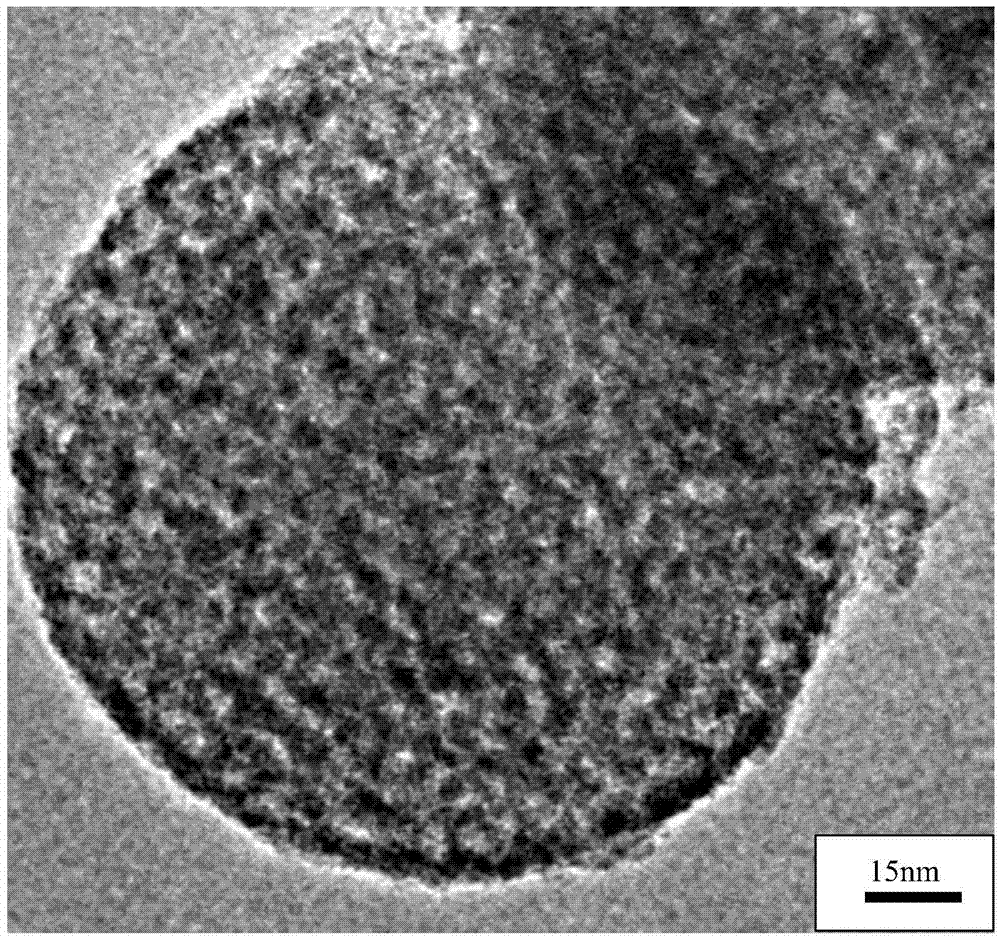Fe and N co-doped mesoporous TiO2 microsphere array visible light photocatalyst and preparation method
A titanium dioxide, microsphere array technology, applied in physical/chemical process catalysts, chemical instruments and methods, chemical/physical processes and other directions, can solve the problems of low photon quantum efficiency, difficult industrial application, difficult to achieve separation and utilization, etc., to achieve repeated Good properties, reduced compounding rate, and easy control of preparation parameters
- Summary
- Abstract
- Description
- Claims
- Application Information
AI Technical Summary
Problems solved by technology
Method used
Image
Examples
Embodiment 1
[0023] (1) Mix 18ml, 60ml, 320ml of deionized water, 13mol / L ammonia water and absolute ethanol, stir at 30°C for 1 hour, then add 29.16g of tetraethyl orthosilicate and 400ml of Anhydrous ethanol mixture, stirred at 30°C for 20h, after the reaction, washed with ethanol and deionized water several times, centrifuged at a slow speed for 10h to self-assemble, calcined at 750°C, and then soaked in benzoyl peroxide and methyl Polymerize at 60°C in a solution with a mass ratio of methyl acrylate of 1:84. The excess polymer was removed with tetrahydrofuran, and the silica template was removed with 5% HF solution to obtain a PMMA (polymethyl methacrylate) counter template.
[0024] (2) Add 2.84g of isopropyl titanate dropwise to 2.4g of hydrochloric acid solution, stir for 1 hour, and record as solution A; add 1.16g of mesoporous agent P123 to 4g of absolute ethanol, stir until dissolved, and record as solution B solution; then the B solution is divided into two parts, one part is a...
Embodiment 2
[0029] The preparation method of Fe, N co-doped titania microsphere array catalyst, the steps are the same as in Example 1, the difference is: used 0.65% FeCl 3 .6H 2 The mass of O in ethanol is 0.1 g
[0030] Weigh 0.02g of Fe, N co-doped titanium dioxide opal catalyst prepared above to carry out the experiment of visible light catalytic degradation of rhodamine B, the concentration of rhodamine B is 5mg L -1 , rhodamine after visible light irradiation for 100min
Embodiment 3
[0032] The preparation method of Fe, N co-doped titania opal catalyst, step is the same as embodiment 1, difference is: used 0.65%FeCl 3 .6H 2 The mass of O in ethanol is 0.3 g
[0033] Weigh 0.02g of Fe, N co-doped titanium dioxide opal catalyst prepared above to carry out the experiment of visible light catalytic degradation of rhodamine B, the concentration of rhodamine B is 5mg L -1 , the degradation rate of rhodamine B after visible light irradiation for 100min was 91.2%.
PUM
| Property | Measurement | Unit |
|---|---|---|
| diameter | aaaaa | aaaaa |
| diameter | aaaaa | aaaaa |
Abstract
Description
Claims
Application Information
 Login to View More
Login to View More - R&D
- Intellectual Property
- Life Sciences
- Materials
- Tech Scout
- Unparalleled Data Quality
- Higher Quality Content
- 60% Fewer Hallucinations
Browse by: Latest US Patents, China's latest patents, Technical Efficacy Thesaurus, Application Domain, Technology Topic, Popular Technical Reports.
© 2025 PatSnap. All rights reserved.Legal|Privacy policy|Modern Slavery Act Transparency Statement|Sitemap|About US| Contact US: help@patsnap.com



